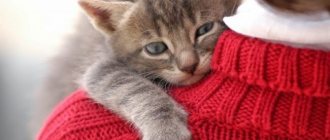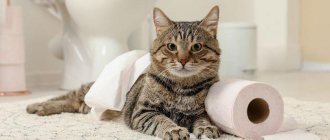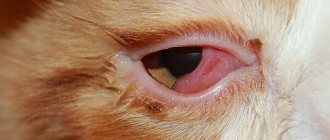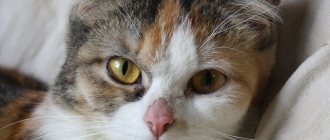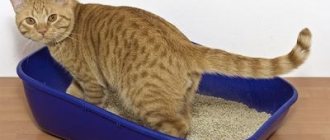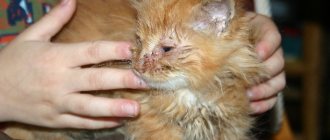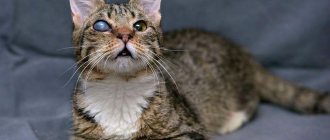The so-called periaucular alopecia (the appearance of characteristic bald patches near the ears) is a common phenomenon in many cats. Other signs of skin pathologies are often absent. Most often, symptoms of alopecia appear in cats with short hair; itching is completely absent.
Alopecia, as a rule, is heterogeneous in nature, covers the entire ear area, and can spread to other areas of the animal’s skin. We will discuss further why this pathology occurs.
Causes of alopecia
The reasons why a cat develops a bald spot behind the ear, or only the tips of the hearing organs are hairless, can be very diverse. It is worth considering the most common among them.
Genetic abnormalities
Hypotrichosis is considered a genetic, inherited disorder. As a rule, it manifests itself at an early age. Kittens remain without fur, and then grow it again.
The pathology is extremely rare and does not pose a threat to the pet’s life. True, it is practically not amenable to therapy. Such cats are not allowed for breeding.
Avitaminosis
The cat's body does not produce vitamin A.
The animal receives it with food. If there is a shortage of this substance, the condition of the coat and skin worsens, and the appearance of baldness is possible.
Obesity
With excess body weight, the sebaceous glands become inflamed and dermatitis develops. Alopecia is also possible.
Due to the fact that the cat cannot provide adequate care for its fur, baldness occurs.
Such a pet needs to be given special food that helps reduce body weight.
Psychological alopecia
Sometimes baldness occurs in animals that are under stress.
When nervous, the cat begins to calm itself down through constant licking. But if you suspect psychogenic alopecia, you should not exclude an allergic reaction, which can also lead to baldness .
Reaction to medications taken
Bald spots in the ear area can appear as a result of taking medications.
If such a reaction occurs, you should contact your veterinarian and replace or completely discontinue the drug.
Helminthiasis
When the body is infected with worms, metabolic processes are disrupted and the immune system is suppressed. A deterioration in the condition of the coat indicates helminthic infestation. In neglected situations, bald spots appear.
Failure of the endocrine system
With endocrine disorders, bald areas also appear. Disturbances in the activity of the thyroid gland, problems with the adrenal glands, sterilization and diabetes can lead to hormonal imbalance.
Infectious alopecia
The appearance of bald areas on the ears is often observed when an infection enters the body. It can affect the respiratory tract, intestines or eyes.
To choose treatment tactics, you must consult a veterinarian.
Lichen
The pathology is caused by fungi and poses a serious danger to people.
The disease manifests itself in the form of bald round areas on which there are remnants of hair (their root part). The skin is covered with scales. The pet suffers from severe itching and scratches the affected areas. Gradually they become larger.
Mechanical factor
This type of baldness is the easiest to eliminate.
Bald spots can appear after a fight with other animals or injury. Special therapy is not required in this case.
Over time, the condition will normalize and new hair will grow.
How to treat: effective methods
A veterinarian will help determine the causes of hair loss in your pet, who will conduct an examination and prescribe therapy.
When self-induced alopecia appears in cats, as a result of which the stomach, ears, heels and often other bodies become bald, then you should not delay a visit to the veterinarian. The doctor will find out why hair grows poorly and falls out around the ears, and then select the necessary therapeutic actions. If a cat has hair loss above the eyes due to an allergic reaction, then no special treatment may be required, but it is enough to exclude the animal from contact with the allergen. For a pet that may be irritated by certain odors and other substances, it is worth choosing hypoallergenic food so that the pathology does not recur and complications do not arise. In case of advanced allergies, due to which the stomach, ears and other areas become bald, medications with antihistamine action will be required to eliminate alopecia in cats.
Bald patches caused by bacteria or viruses need to be treated with medication using various means. The following groups of medications are used to eliminate bald spots:
- antibiotics;
- immunostimulants;
- vitamin complexes.
A cat's receding hairline also requires adjustments to its daily diet. The pet needs to be fed high-quality food that contains the vitamins and microelements necessary for the cat’s body. Often, hairless cats and other members of the feline family encounter problems due to severe stress. If the deviation cannot be resolved without medication, then pills are prescribed that improve the animal’s mood.
Symptoms You Shouldn't Ignore
If the animal notices the appearance of completely bare areas of the skin or is covered with excessively sparse hair, then it is necessary to consult a doctor. Also of concern are peeling, redness, itching and crusting.
All these symptoms cannot be ignored: there is a high probability that your pet is developing a serious illness.
Signs of pathology
Alopecia is an anomaly that occurs due to a malfunction in the body and requires medical intervention. Large bald areas and bald spots on the pet's body should alert the owner.
Signs of pathology:
- severe hair loss during scratching and walking;
- the hair falls out in clumps, leaving bald areas in the area of the ears, back, tail and other parts of the body;
- the hair on one side is thicker than on the other;
- the skin on bald areas is not pinkish, as it should be normally, but red;
- peeling, ulcers, wounds and scabs are noticeable on the skin;
- the animal scratches the bald spot vigorously, possibly to the point of bleeding;
- touching the skin causes anxiety in the cat or, conversely, apathy.
If you notice one or more of the listed symptoms in your pet, take immediate action.
Remember that timely treatment is much more effective than therapy in severe stages of the disease.
How to help a cat
Treatment is selected taking into account the general health of the pet and the factors that provoked baldness.
Medications
After determining the cause of baldness, certain groups of drugs are prescribed:
Allergy. Immunostimulating and antihistamines are prescribed.- Parasites. They resort to the use of antiparasitic drugs.
- Infection. Antibiotics are used, for example Amoxicillin.
- Stress. Drugs that have a sedative effect are used.
- Lichen. Antifungal agents are prescribed. The most commonly used are Ketoconazole or Griseofulvin. In addition, agents are used that stimulate metabolic processes and support immunity.
- Endocrine system disorders. Hormonal medications are indicated.
Traditional medicine
Resorting to the use of folk remedies is strongly discouraged. Often, when using them, there is a deterioration in the animal’s condition.
In addition to drug therapy, it is worth excluding potential allergens from your pet’s menu and providing him with peace. Self-medication is strictly prohibited .
Treatment options
Having determined the diagnosis, the specialist prescribes treatment. It is aimed at restoring the coat, as well as neutralizing the cause of baldness in the cat.
Treatment methods:
- If the problem is related to an allergic reaction, the animal must be completely protected from the allergen. After this, medications are prescribed to improve immunity. If the allergy is caused by food, then it is necessary to put the cat on a diet.
- Skin lesions from mites and lice must be treated with special antiparasitic drugs. The diet includes vitamins and nutritional supplements to strengthen the immune system.
- If a bald spot on a cat’s body appears due to an infectious disease, the doctor will prescribe a course of antibiotic therapy. As a rule, Amoxicillin is used for this.
- Baldness caused by stress in an animal is treated with special sedatives.
- Alopecia caused by demodicosis is treated by bathing with sulfur-selenium shampoo (1%).
- If the veterinarian has diagnosed ringworm, then treatment is carried out with the following drugs: Ketoconazole, Itraconazole, Griseofulfin, and so on. In this case, it is recommended to use immunosupportive agents and medications to improve metabolism. It is important to remember that ringworm is transmitted to humans.
- For endocrine disorders, hormonal drugs are prescribed.
- Skin abscesses are treated with local or systemic antibiotics, as well as antiseptics.
Use medications prescribed by your veterinarian. Self-medication can harm the animal, especially if you use the wrong medicine or do not maintain the permissible dosage.
How to accurately determine the cause
In order to make an accurate diagnosis, the doctor examines the animal, listens to the owner’s complaints, and takes an anamnesis.
Additional diagnostic procedures may be prescribed:
study of hair follicles;- blood analysis;
- determination of hormone levels;
- skin scraping;
- X-ray;
- Ultrasound.
Stages of the disease
Telogen effluvium, which is where telogen effluvium occurs, can develop in three directions:
- Chronic. It is caused by an unbalanced diet and a deficiency of vital elements.
- Spicy. The cause of acute telogen efflux is most often severe stress and a state of shock.
- Postpartum. Baldness progresses against the background of hormonal imbalance, endocrine disorders, and disruptions in the functioning of the immune system.
Depending on the nature of the course and intensity of progression, three stages of telogen alopecia are distinguished:
- Easy. At the initial stage, the hair becomes thinner in the frontal-central part of the head. Noticeable gaps also form in the central and parietal zones. The hair shaft itself is not damaged, but the bulb looks thinned and discolored.
- Average. As alopecia progresses, the size of the gaps increases. Curls become dull, brittle, thin, lifeless. Thinning of the hair becomes especially noticeable when styling it in the middle.
- Heavy. The very last stage, which occurs as a result of untimely treatment of the pathology. At this stage, large areas of baldness form throughout the central part of the head, as well as in the parietal area. The hair shafts are thinned, discolored, and look like fluff.
Prevention measures
To avoid hair problems, you need to follow these recommendations:
- choose high-quality food that matches the condition and age of the cat;
Give your pet antihelminthics at intervals of three months;- regularly treat the animal for fleas;
- eliminate all factors that can lead to the development of allergies;
- vaccinate in a timely manner;
- provide your pet with complete care.
Treatment of bald ears in cats
Only a veterinarian can provide full assistance to a cat in such a situation; independent treatment is not the best option here. Only a doctor can determine the disease and formulate a treatment plan.
If your cat's ears are going bald due to allergies, you will have to change the environment a little. Perhaps some flowers will disappear from the apartment interior, and the hostess will have to part with her favorite perfume. To avoid a repeat reaction, it is better for the animal to eat hypoallergenic food.
Bacterial and viral infections are treated with a special set of drugs, a new diet and the introduction of vitamin complexes into the diet.
The effects of emotional turmoil may need to be treated with mood modifier pills. Of course, this is not the best outcome, but the cat owner needs to prepare in advance for such a verdict.
© shutterstock
